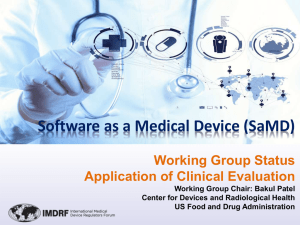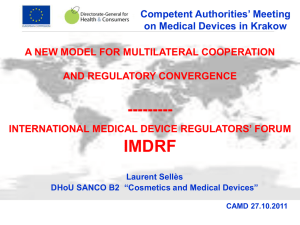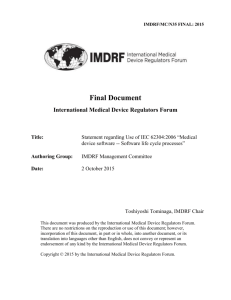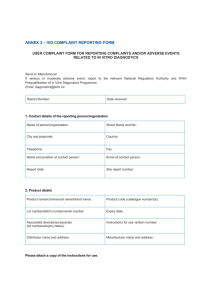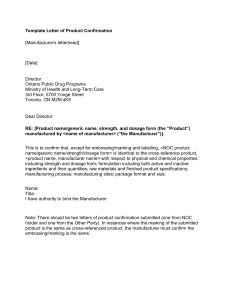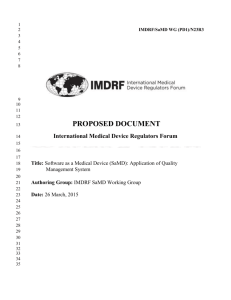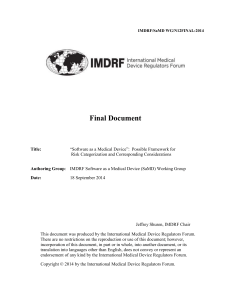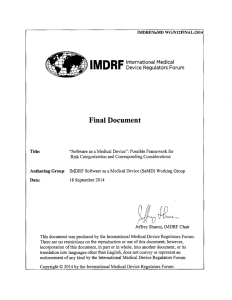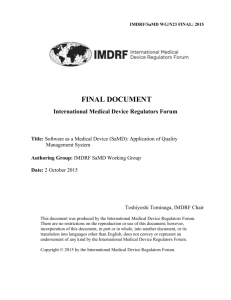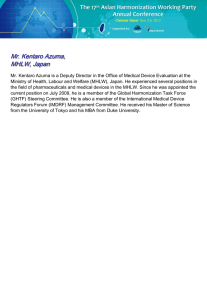Software as a Medical Device (SaMD): Key Definitions
advertisement
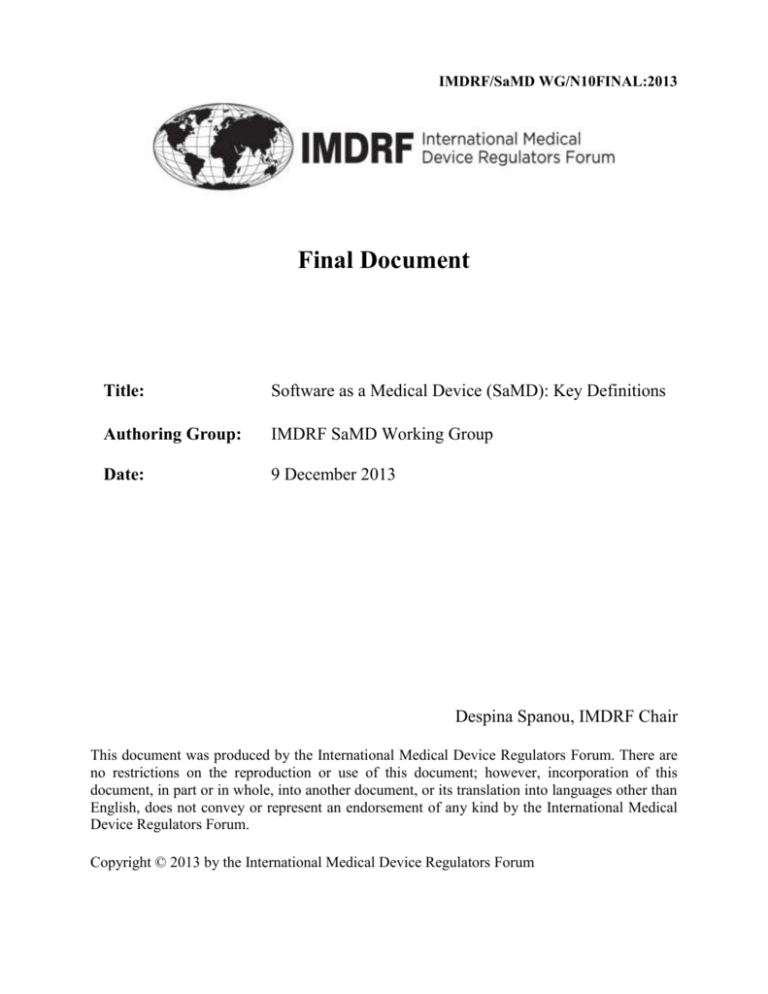
IMDRF/SaMD WG/N10FINAL:2013 Final Document Title: Software as a Medical Device (SaMD): Key Definitions Authoring Group: IMDRF SaMD Working Group Date: 9 December 2013 Despina Spanou, IMDRF Chair This document was produced by the International Medical Device Regulators Forum. There are no restrictions on the reproduction or use of this document; however, incorporation of this document, in part or in whole, into another document, or its translation into languages other than English, does not convey or represent an endorsement of any kind by the International Medical Device Regulators Forum. Copyright © 2013 by the International Medical Device Regulators Forum IMDRF/SaMD WG/N10FINAL:2013 _______________________________________________________________________________________ Table of Contents 1.0 Introduction .......................................................................................................................... 4 2.0 Scope .................................................................................................................................... 5 3.0 References ............................................................................................................................ 5 4.0 Definitions............................................................................................................................ 5 5.0 Key Definitions .................................................................................................................... 6 5.1 Software as a Medical Device .......................................................................................... 6 5.2 Medical purpose ............................................................................................................... 6 5.2.1 Medical Device ......................................................................................................... 6 5.2.2 In Vitro Diagnostic (IVD) medical device................................................................ 7 5.2.3 Additional considerations for SaMD ........................................................................ 7 5.3 SaMD Changes ................................................................................................................. 8 5.4 SaMD Manufacturer ......................................................................................................... 8 5.5 Intended use / intended purpose ....................................................................................... 9 5.5.1 Additional considerations for SaMD ........................................................................ 9 9 December 2013 Page 2 of 9 IMDRF/SaMD WG/N10FINAL:2013 _______________________________________________________________________________________ Preface The document herein was produced by the International Medical Device Regulators Forum (IMDRF), a voluntary group of medical device regulators from around the world. The document has been subject to consultation throughout its development. There are no restrictions on the reproduction, distribution or use of this document; however, incorporation of this document, in part or in whole, into any other document, or its translation into languages other than English, does not convey or represent an endorsement of any kind by the International Medical Device Regulators Forum. 9 December 2013 Page 3 of 9 IMDRF/SaMD WG/N10FINAL:2013 _______________________________________________________________________________________ 1.0 Introduction Software is becoming increasingly important and pervasive in healthcare. Given the availability of a multitude of technology platforms (e.g., personal computers, smart phones, network servers, etc.), as well as increasing ease of access and distribution (e.g., internet, cloud), software created for medical purposes (software used to make clinical decisions) and non-medical purpose (e.g., administrative, financial) are being used in healthcare. In general, existing regulations address public health risks of software when embedded in a traditional medical device. However, the current application of regulations and controls may not always translate or address the unique public health risks posed by Software as a Medical Device (SaMD) nor assure an appropriate balance between patient/consumer protection and promotion of public health by facilitating innovation. This is the first of a collection of documents that will be developed by the International Medical Device Regulators Forum (IMDRF) to establish a common framework for regulators to incorporate converged controls into their regulatory approaches for SaMD.. This collection of IMDRF SaMD documents will provide regulators with the fundamental building blocks and a common understanding of the many kinds and importance of software for medical purposes in advancing public health. Generally medical purpose software1 consists of: (1) software in a medical device (sometimes referred to as “embedded” or “part of”); (2) software as a medical device (SaMD). This document IMDRF SaMD WG N10/Software as a Medical Device2: Key Definitions focuses on a common definition for when software is considered to be a medical device and a reminder of other key terms, some previously defined in Global Harmonization Task Force (GHTF) documents, with relevance to SaMD. The key definitions and terms developed in IMDRF SaMD WG N10 will be used to develop future documents that provide a common framework for identifying types of SaMD and associated risks and controls to minimize these risks. Some regulators have taken individual approaches to assure safety, effectiveness, and performance of SaMD. Such approaches have common public health goals. The objective of this effort is to promote consistent expectations for SaMD and to provide an optimal level of patient safety while fostering innovation and ensuring patients and providers have continued access to advances in healthcare technology. 1 Software used to make or maintain a device (testing, source code management, servicing, etc.) is not considered software with a medical purpose. 2 This IMDRF document converges on the term SaMD to replace the term “standalone software” or “standalone medical device software”. However the concepts of standalone software are included in this converged definition of SaMD. 9 December 2013 Page 4 of 9 IMDRF/SaMD WG/N10FINAL:2013 _______________________________________________________________________________________ 2.0 Scope This document IMDRF SaMD WG N10/Software as a Medical Device: Key Definitions focuses on a common definition for when software is considered to be a medical device and a reminder of other key terms, some previously defined in Global Harmonization Task Force (GHTF) documents, with relevance to SaMD. Software intended as an accessory to a medical device is not in the scope of this document, unless the software meets the definition of SaMD in this document. This document focuses on the definition of the SaMD irrespective of software technology and/or platform (e.g., mobile app, cloud). 3.0 References GHTF/SG1/N55:2008 Definition of the Terms Manufacturer, Authorised Representative, Distributor and Importer GHTF/SG1/N70:2011 Label and Instructions for Use for Medical Devices GHTF/SG1/N71:2012 Definition of Terms Medical Device and In Vitro Diagnostic Medical Device ISO/IEC 14764:2006 Software Engineering — Software Life Cycle Processes — Maintenance 4.0 Definitions This section is intentionally left blank as the definitions are contained within the body of this document. 9 December 2013 Page 5 of 9 IMDRF/SaMD WG/N10FINAL:2013 _______________________________________________________________________________________ 5.0 Key Definitions 5.1 Software as a Medical Device The term “Software as a Medical Device” (SaMD) is defined as software intended to be used for one or more medical purposes that perform these purposes without being part of a hardware medical device. NOTES: SaMD is a medical device and includes in-vitro diagnostic (IVD) medical device. SaMD is capable of running on general purpose (non-medical purpose) computing platforms3 “without being part of” means software not necessary for a hardware medical device to achieve its intended medical purpose; Software does not meet the definition of SaMD if its intended purpose is to drive a hardware medical device. SaMD may be used in combination (e.g., as a module) with other products including medical devices; SaMD may be interfaced with other medical devices, including hardware medical devices and other SaMD software, as well as general purpose software Mobile apps that meet the definition above are considered SaMD. 5.2 Medical purpose The following two terms as defined in GHTF/SG1/N71:2012 (italicized below) identify medical purpose applicable to SaMD: 5.2.1 Medical Device ‘Medical device’ means any instrument, apparatus, implement, machine, appliance, implant, reagent for in vitro use, software, material or other similar or related article, intended by the manufacturer to be used, alone or in combination, for human beings, for one or more of the specific medical purpose(s) of: diagnosis, prevention, monitoring, treatment or alleviation of disease, diagnosis, monitoring, treatment, alleviation of or compensation for an injury, investigation, replacement, modification, or support of the anatomy or of a physiological process, supporting or sustaining life, control of conception, 3 “Computing platforms” include hardware and software resources (e.g. operating system, processing hardware, storage, software libraries, displays, input devices, programming languages etc.). “Operating systems” that SaMD require may be run on a server, a workstation, a mobile platform, or other general purpose hardware platform. 9 December 2013 Page 6 of 9 IMDRF/SaMD WG/N10FINAL:2013 _______________________________________________________________________________________ disinfection of medical devices, providing information by means of in vitro examination of specimens derived from the human body; and does not achieve its primary intended action by pharmacological, immunological or metabolic means, in or on the human body, but which may be assisted in its intended function by such means. Note: Products which may be considered to be medical devices in some jurisdictions but not in others include: disinfection substances, aids for persons with disabilities, devices incorporating animal and/or human tissues, devices for.in-vitro fertilization or assisted reproduction technologies. 5.2.2 In Vitro Diagnostic (IVD) medical device ‘In Vitro Diagnostic (IVD) medical device’ means a medical device, whether used alone or in combination, intended by the manufacturer for the in-vitro examination of specimens derived from the human body solely or principally to provide information for diagnostic, monitoring or compatibility purposes. Note 1: IVD medical devices include reagents, calibrators, control materials, specimen receptacles, software, and related instruments or apparatus or other articles and are used, for example, for the following test purposes: diagnosis, aid to diagnosis, screening, monitoring, predisposition, prognosis, prediction, determination of physiological status. Note2: In some jurisdictions, certain IVD medical devices may be covered by other regulations. 5.2.3 Additional considerations for SaMD SaMD may also: provide means and suggestions for mitigation of a disease; provide information for determining compatibility, detecting, diagnosing, monitoring or treating physiological conditions, states of health, illnesses or congenital deformities; be an aid to diagnosis, screening, monitoring, determination of predisposition; prognosis, prediction, determination of physiological status. 9 December 2013 Page 7 of 9 IMDRF/SaMD WG/N10FINAL:2013 _______________________________________________________________________________________ 5.3 SaMD Changes SaMD Changes refer to any modifications made throughout the lifecycle of the SaMD including the maintenance phase. Software maintenance4 can include adaptive (e.g. keeps pace with the changing environment), perfective (e.g. recoding to improve software performance), corrective (e.g. corrects discovered problems), or preventive (e.g. corrects latent faults in the software product before they become operational faults). Examples of SaMD changes include, but are not limited to, defect fixes; aesthetic, performance or usability enhancements; and security patches. 5.4 SaMD Manufacturer For SaMD manufacturer the definition in GHTF/SG1/N55:2009 applies: “Manufacturer” means any natural or legal person5 with responsibility for design and/or manufacture of a medical device with the intention of making the medical device available for use, under his name; whether or not such a medical device is designed and/or manufactured by that person himself or on his behalf by another person(s). NOTES: 1. This ‘natural or legal person’ has ultimate legal responsibility for ensuring compliance with all applicable regulatory requirements for the medical device in the countries or jurisdictions where it is intended to be made available or sold, unless this responsibility is specifically imposed on another person by the Regulatory Authority (RA) within that jurisdiction. 2. The manufacturer’s responsibilities are described in other GHTF guidance documents. These responsibilities include meeting both pre-market requirements 4 ISO/IEC 14764:2006 Software Engineering — Software Life Cycle Processes — Maintenance adaptive maintenance: the modification of a software product, performed after delivery, to keep a software product usable in a changed or changing environment. perfective maintenance: the modification of a software product after delivery to detect and correct latent faults in the software product before they are manifested as failures corrective maintenance: the reactive modification of a software product performed after delivery to correct discovered problems preventive maintenance: the modification of a software product after delivery to detect and correct latent faults in the software product before they become operational faults 5 The term “person” that appears here and in the other definitions of this document, includes legal entities such as a corporation, a partnership or an association. 9 December 2013 Page 8 of 9 IMDRF/SaMD WG/N10FINAL:2013 _______________________________________________________________________________________ and post-market requirements, such as adverse event reporting and notification of corrective actions. 3. ‘Design and/or manufacture’, as referred to in the above definition, may include specification development, production, fabrication, assembly, processing, packaging, repackaging, labelling, relabelling, sterilization, installation, or remanufacturing of a medical device; or putting a collection of devices, and possibly other products, together for a medical purpose. 4. Any person who assembles or adapts a medical device that has already been supplied by another person for an individual patient, in accordance with the instructions for use, is not the manufacturer, provided the assembly or adaptation does not change the intended use of the medical device. 5. Any person who changes the intended use of, or modifies, a medical device without acting on behalf of the original manufacturer and who makes it available for use under his own name, should be considered the manufacturer of the modified medical device. 6. An authorised representative, distributor or importer who only adds its own address and contact details to the medical device or the packaging, without covering or changing the existing labelling, is not considered a manufacturer. 7. To the extent that an accessory is subject to the regulatory requirements of a medical device6, the person responsible for the design and/or manufacture of that accessory is considered to be a manufacturer. 5.5 Intended use / intended purpose For SaMD intended use, the definition in GHTF/SG1/N70:2011 “Label and Instructions for Use for Medical Devices” applies: The term “intended use / intended purpose” is the objective intent of the manufacturer regarding the use of a product, process or service as reflected in the specifications, instructions and information provided by the manufacturer. 5.5.1 Additional considerations for SaMD Although not specifically included in the GHTF definition materials such as sales and marketing materials may be considered as “information provided by the manufacturer” and therefore reflect the objective intent of the manufacturer. Sales and marketing materials should be comprehensive and reflect the intended use of the SaMD. 6 See GHTF/SG1/N29 Information Document Concerning the Definition of the Term “Medical Device” 9 December 2013 Page 9 of 9
